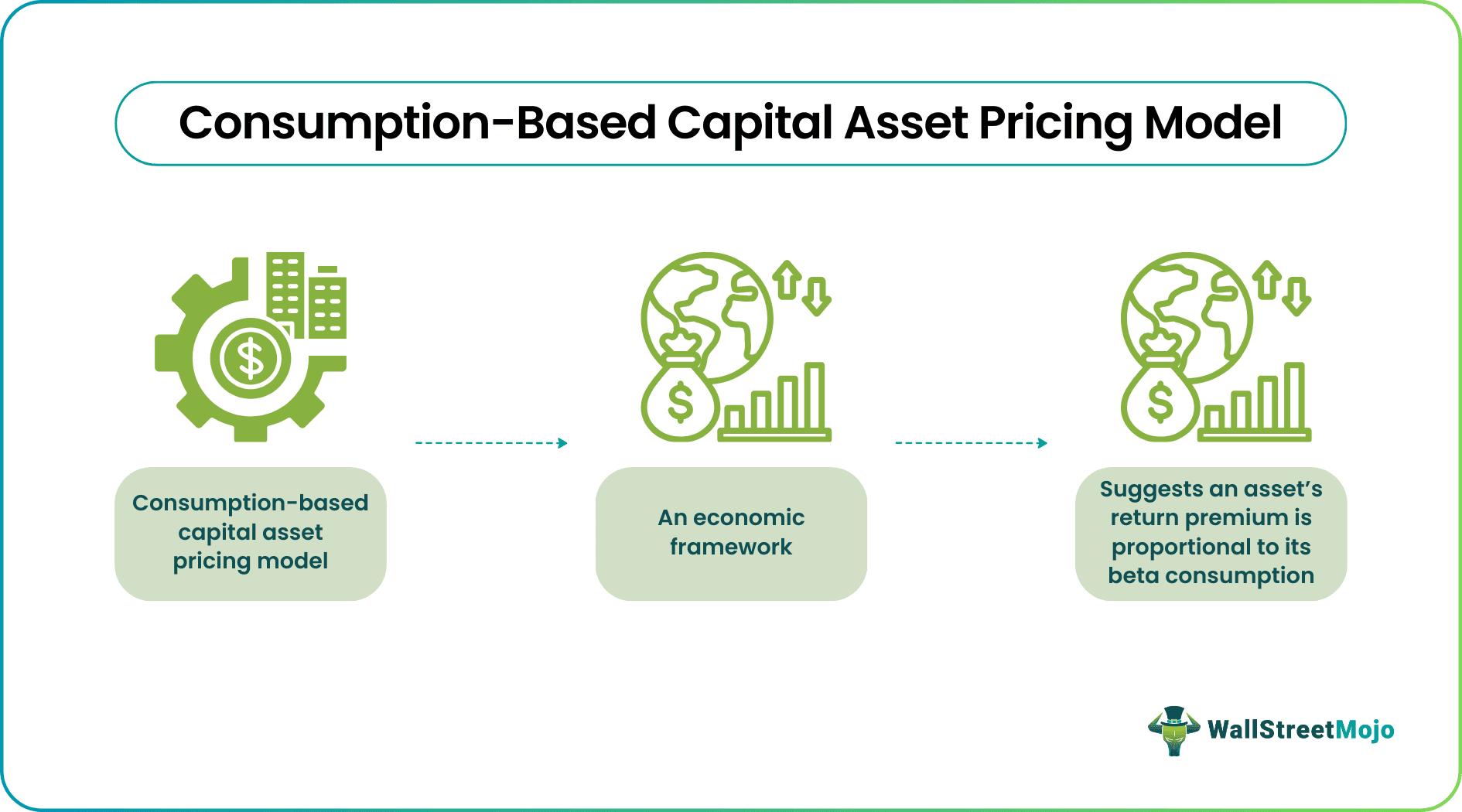Consumption-Based Capital Asset Pricing Model
Table Of Contents
What Is Consumption-Based Capital Asset Pricing Model (CCAPM)?
The Consumption-Based Capital Asset Pricing Model (CCAPM) is an economic framework that explains the relationship between asset prices and the consumption decisions of investors. It is an extension of the traditional Capital Asset Pricing Model. It aims to analyze asset pricing and the behavior of financial markets by providing insights into the relationship between consumption decisions and asset prices.

The CCAPM suggests that asset prices are determined by the trade-off between their current consumption and future consumption. According to this model, investors are concerned about an asset's expected return and risk. Moreover, they care about how it affects their consumption patterns over time. Furthermore, the CCAPM assumes investors are risk-averse and prefer smoothing their consumption over time.
Key Takeaways
- The Consumption-Based Capital Asset Pricing Model is an economic model suggesting that consumptions influence asset prices and returns.
- The model helps analyze asset prices and the behavioral patterns of financial markets. Additionally, it offers insights into the relationship between consumption decisions and asset prices.
- It states that asset prices are evaluated by the trade-off between their current and future consumption.
Consumption-Based Capital Asset Pricing Model Explained
The Consumption-Based Capital Asset Pricing Model (CCAPM) is a financial model that explains the relationship between asset prices and the investor's consumption decisions. However, it is an extension of the traditional Capital Asset Pricing Model. It suggests that an asset's return premium is influenced by its consumption beta. According to this model, asset prices are determined by the trade-off between their present and future consumption.
The model assumes that investors are risk-averse and prefer smoothing their consumption over time. Additionally, it assumes that investors are concerned about the utility they derive from consumption. Moreover, they are willing to take more risks to maximize their well-being. Furthermore, this model recognizes that the risk premium of an asset is directly related to the covariance between the asset's return and the investor's marginal utility of consumption.
Video on CAPM
Formula
The Consumption-Based Capital Asset Pricing Model formula is as follows:

Importance
The CCAPM importance is as follows:
- The CCAPM recognizes that investors give importance to the timing and smoothness of their consumption over time. Thus, it provides a more realistic and comprehensive framework for understanding investor behavioral patterns.
- The model helps provide insights into why investors demand higher expected returns for assets negatively correlated with their consumption utility by considering the relationship between consumption and asset prices.
- This model offers valuable insights into the determinants of asset prices. However, it suggests that the risk premium of an asset is related to the covariance between its return and the investor's marginal utility of consumption. Additionally, this framework helps researchers and investors more accurately analyze and predict asset price movements and risk premiums.
- The CCAPM identifies that the investors are risk-averse and prefer to smooth their consumption over time. Moreover, by incorporating these factors, the model offers a setting to evaluate how asset price and risk changes impact investors' consumption decisions. It explains how investors allocate their wealth between different assets based on consumption patterns and risk appetite preferences.
- The model guides investment decision-making. Additionally, investors can make more informed choices about portfolio allocation by considering the relationship between consumption and asset prices. Furthermore, the application of the consumption-based capital asset pricing model assists in determining the appropriate risk premiums required for assets based on their correlation with investors' consumption utility.
Criticism
The criticisms that the CCAPM faces are:
- The application of the consumption-based capital asset pricing model requires estimating various parameters and variables, including consumption growth rates, risk-free rates, and covariance between asset returns and consumption. However, performing these estimations can be complex and subject to data limitations, resulting in potential inaccuracies in the model's predictions.
- The model relies on assumptions like constant relative risk aversion and a perfect capital market. However, these assumptions may oversimplify the complexities of the actual financial markets and investor behavior patterns. Moreover, its predictions may not accommodate more realistic settings where investors exhibit time-varying risk aversion or face constraints on borrowing and lending.
- The CCAPM's ability to explain the cross-section of asset returns, especially the variation in expected returns across different assets, is criticized. Additionally, the model may not efficiently account for factors beyond consumption patterns that drive asset prices, including market sentiment, liquidity considerations, or investor sentiment.
- This model's predictions can be sensitive to the values assigned to several parameters, like risk aversion. Moreover, small changes in these parameter values can significantly affect the model's outcomes and raise concerns about its robustness and dependability.
- The CCAPM is one of several asset pricing models with no consensus on its superiority over alternative models. Since different models offer alternative explanations for asset pricing phenomena, the CCAPM's limitations may refrain investors from using this model.
CCAPM vs Capital Asset Pricing Model
CCAPM
- This model considers investors and identifies that they care about their consumption's timing and smoothness over time. The investors account for these preferences.
- Additionally, it offers insights into the relationship between consumption decisions and asset prices.
- The CCAPM incorporates consumption risk as it suggests that the risk premium of an asset is related to the covariance between its return and the investor's marginal utility of consumption.
- This model offers insights into why investors demand higher expected returns from assets negatively correlated with their consumption utility by considering the relationship between consumption and asset prices.
Capital Asset Pricing Model (CAPM)
- CAPM assumes that the risk and return of an asset are determined only by its systematic risk, represented by beta.
- It suggests that investors are only concerned with the covariance between an asset and the market return, and risk premiums are based on this relationship.
- The model assumes that all investors, including all risky investments, hold the market portfolio. It suggests that an asset's risk and return are determined by its sensitivity to market movements instead of its specific characteristics.
- The CAPM is widely accepted and practiced due to its simplicity and ease of application. It provides a simplified framework for estimating the expected return on an asset based on its beta and the market risk premium.

